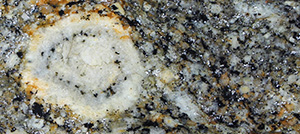Megacrysts and Megeacryst Transfer Across Magmas, Kangaroo Island, South Australia
|
| Along the south coast of Kangaroo Island, we found three distinct coarse-grained Bt-Ms granites with large megacrysts of K-feldspar. All three granites are
essentially very similar and so are the megacrysts. This page describes their diffences and similarities.
These granites are found in two separate areas and are found intruding broadly contemporaneous migmatites. One area is west of Vivonne Bay (Seal Rock) and the other
is close to Little Dicky Beach in Six Mile Lagoon. In the latter, an older coarser-granite with a gneissic foliation is partly digested by a younger finer-grained and
more felsic granite which seems to inherit some megacrysts through assimilation of the gneissic granite (megacryst transfer).
Megacrysts in all granites are large (upto 10 cm), and tending to equidimensional (aspect ratios close to unity). They are typically euhedral, some times rounded. They have inclusions of Bt, generally randomly distributed, and less commonly in zonal arrangements. The megacrysts in both the older and younger granites at Little Dicky Beach differ in that they also have inclusions of Ms. Bt inclusions here tend to be single grains, whereas at Seal Rock there are also fine-grained 0.5cm clots of Bt+Qtz similar to clots found in the surrounding granite. |
